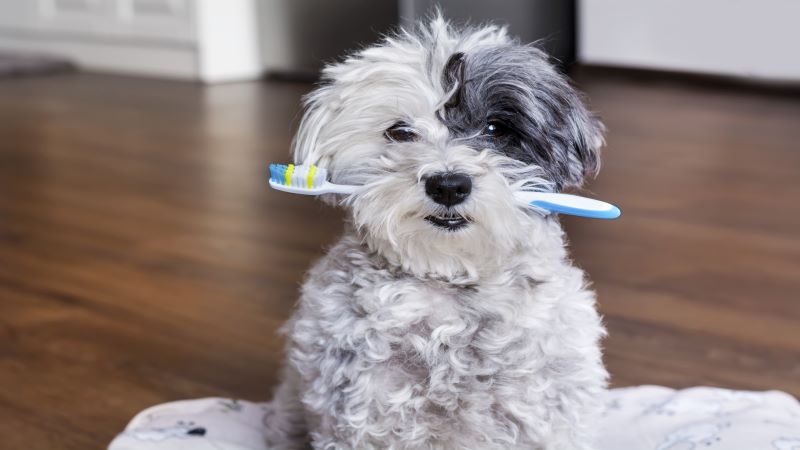The dog’s name was Hally. He lived with the Tosis family. When the children took Hally for a walk, everyone else walked on the other side of the street and one exhale from the dog made the family’s goldfish go belly up. This was a problem, and the Tosis children set out to solve it. They took her to the top of a mountain with a “breathtaking” view, and then to an exciting movie they thought may make Hally “breathless,” but nothing seemed to work. When burglers broke into the house and Hally knocked them out with one nice, big kiss on the mouth, the Tosis family changed their tune and decided Hally was a good dog to have around, “Because life without Hally Tosis just wouldn’t make any scents.”
Dog Breath, The Horrible Trouble with Hally Tosis, by Dav Pilkey is a funny children’s story, but the medical term halitosis is not much of a laughing matter. Stinky breath may make you shy away from a kiss from your pet, but there are some other things you should know about the dangers of gum disease.
Why should I take care of my pet’s teeth?
It can prevent…
-
Halitosis Bad breath, or periodontal disease caused by bacteria
-
Gingivitis An early stage of periodontal disease, it presents itself as a reddening of the gums bordering the teeth.
-
Bacterial Contamination Food particles and bacteria can accumulate in your pet’s mouth, leading to infection.
-
Calculus Over time, the accumulation of bacteria forms plaque. When plaque combines with saliva and minerals it can transform into calculus, which can release toxins and destroy gums.
-
Cavities
-
Loose Teeth/Root Exposure
-
Periodontal Disease Inflammation of a tooth’s deep supporting structures
-
All of the above conditions are detrimental to your pet’s health, and they can also cause a great deal of pain, hindering your dog or cat’s quality of life.
How to care for your pet's teeth
-
Make a vet appointment If you haven’t been brushing your pet’s teeth regularly, it is best to get a thorough evaluation before you begin a dental regimen. Your vet can help you determine if there is dental disease present, and decide on a plan for caring for your pet’s teeth going forward.
-
Brush, brush, brush Takeadvantage of this time and use it as a training opportunity. Use the commands sit and stay to keep your dog in place while you brush. Dr. Patty Khuly recommends brushing once a week at a minimum, and says twice a week is ideal. She offers eleven tips for brushing your pet’s teeth in her post, “Gimme a Break! How Hard Can it be to Brush Your Pet’s Teeth?”.
-
Schedule regular cleanings You have dental cleanings twice a year, why shouldn’t your pet? Aim for prophylactic dental procedures every six months.
PetPartners' Wellness Plan can also help you stay on top of your pet’s dental health. Their DefenderPlus coverage allows for up to $150 toward a dental cleaning each year. Check out their Wellness Care and Prevention to learn more.
Above all, remember that your pet relies on you to keep his/her whole body healthy. Let this be your month to focus on your pet’s dental health. Many veterinarians offer specials for teeth cleaning during the month of February. Now, I’m off to brush my dog’s teeth!

